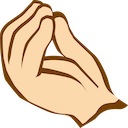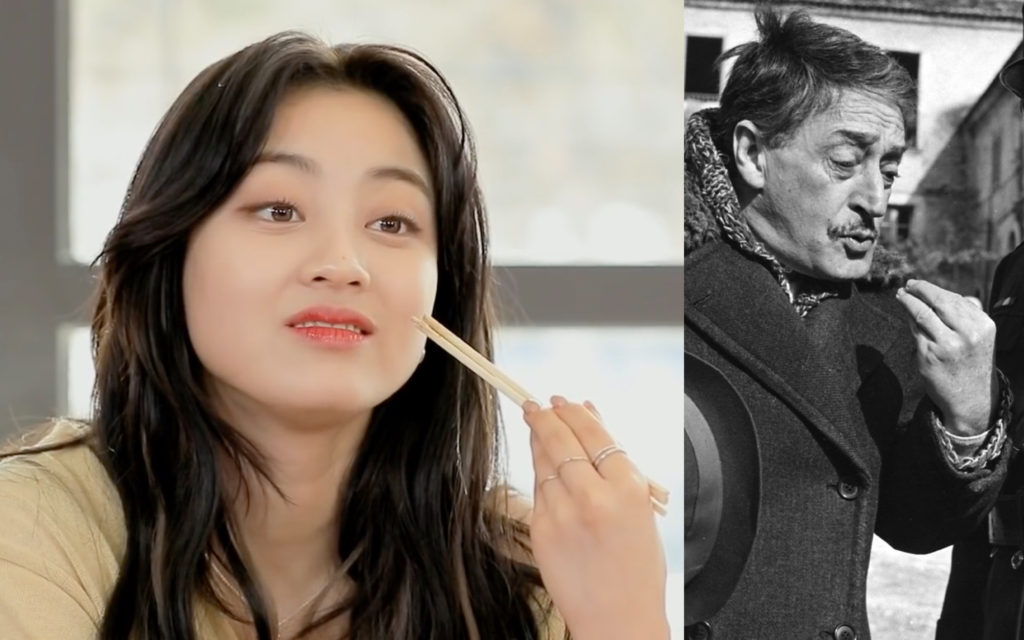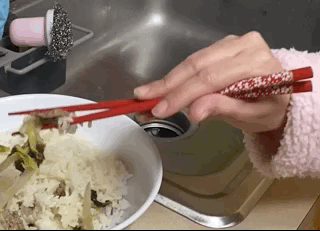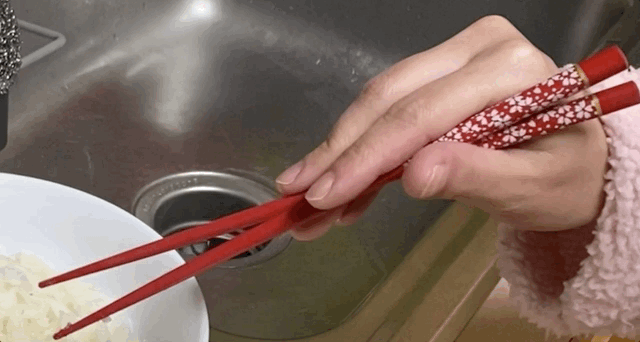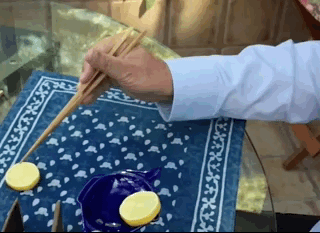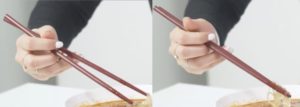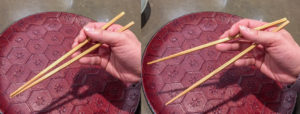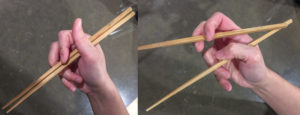Last Updated on July 15, 2022 by Staff
Italian Grip is a cross between Cupped Vulcan and Scissorhand, as we shall shortly discuss. It is named after the Italian hand gesture for “what is it that you want ?!”
Table of Contents
The name
This alternative chopstick grip has all fingertips and the thumb clustered into a point, as does the world-renowned Italian gesture. This gesture goes by many names. Search online for either Ma Che Vuoi or Italian hand, and you shall find plenty of Che Vuoi’s.
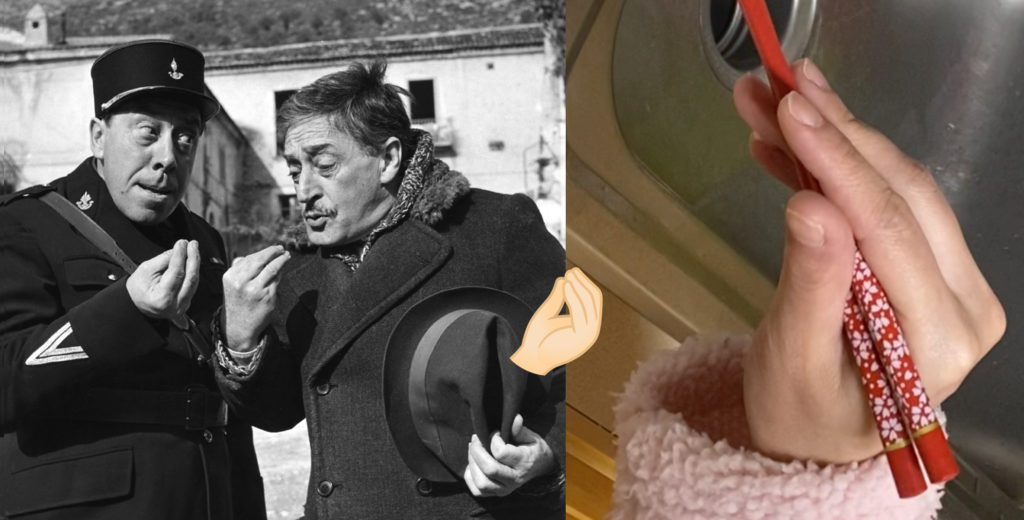
Ma Che Vuoi is pronounced “mah keh voo-oh-yi”. It literally means, “but what do you want”. Some just call it Che Vuoi. That’s what we would really love to call this grip. But most of our readers are not Italians. So we’ll settle for Italian Grip, at marcosticks.org.
It can be used in a whole spectrum of situations, ranging from polite inquiries for clarification, to vulgar “what the @#& do you want?” The degree of frustration is commensurate with how violently the hand is shaken.
Following pictures of Italian Grip are artificially re-oriented in the perspective of the Ma Che Vuoi gesture, for better comparison.

Following is the stereotypical open posture of Italian Grip seen from typical chopstick grip perspectives.

Compared to Cupped Vulcan
From a visual point of view, Italian Grip is easily mistaken as Cupped Vulcan. But subtle differences in finger placements and finger dynamics between them generate substantial differences in their chopsticking operations.
Italian Grip (below left) has all fingertips and the thumb pad converge into one point, in the shape of a pinecone. Cupped Vulcan (below right) instead has four fingers forming a plane. The thumb is on the side, and the thumb pad is not used. Their choices of hand shape (pinecone vs a plane) determine how the two chopsticks are held. Italian Grip clutches all fingers, thus causing the two sticks to be squeezed into one connected pair. Cupped Vulcan keeps the two sticks separate at all times, throughout chopstick motions.
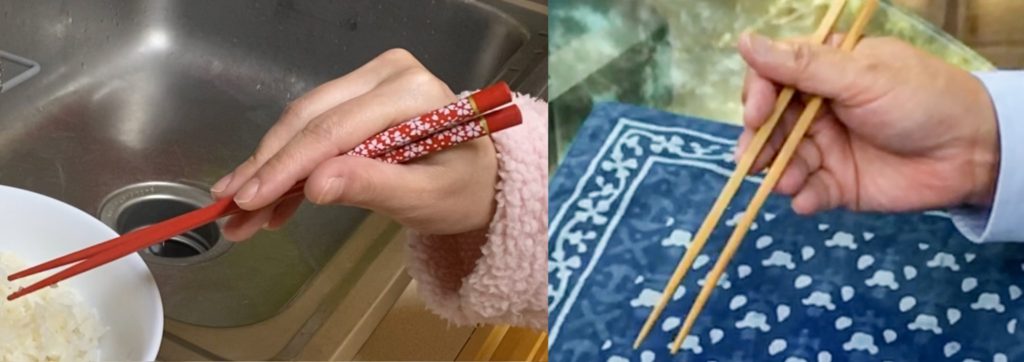
Furthermore, Italian Grip (above left) has the index finger on the top chopstick, and the middle finger on the bottom chopstick. This is similar to Finger Pistol, even though Italian Grip uses a completely different mechanical leverage, compared to Finger Pistol. Cupped Vulcan (above right) has the middle finger on the top chopstick, and the ring finger on the bottom chopstick, in the same configuration as (plain) Vulcan.
With these being said, Italian Grip still shares a great deal of traits with Cupped Vulcan. This article is written using vocabularies we first introduced in Cupped Vulcan. For instance, the idea of a posture that is not closed nor open. The “payload” posture was a distinct feature of Cupped Vulcan, until Italian Grip came along. Now, Italian Grip shares this payload posture as well.
Compared to Scissorhand
Italian Grip may also be mistaken for Scissorhand. They both operate with an under-swing principle. But as will be explained in later sections, the index finger only dabbles in moving the top stick occasionally in Italian Grip. In contrast, Scissorhand relies almost exclusively on the index finger to operate the top chopstick.
The first difference one notices is the orientation of the hand. Italian Grip (below left) has the palm facing down, and the chopsticks extended outward and away. This is the only way the grip is operated. In contrast, Scissorhand has the palm facing the user herself, and tips of chopsticks pointed downward.

Italian Grip (above left) has the thumb extended straight to meet all other four fingers. Scissorhand has the thumb pointed in the opposite direction from the four fingers. The placement and orientation of the thumb cause these two grips to operate in different ways, despite both adopting an under-swing strategy.
As under-swing variants, both Italian Grip and Scissorhand clutch the two chopsticks in the hand, squeezing them until they abut each other. When picking up food, as shown below left, more stick surface from the two sticks come to rest against each other – all fingers squeeze the two sticks together. At the open posture shown below right, only one single contact point exists between the two sticks. And fingers relax to allow sticks to rotate away from each other, thus extending tips apart.
Gravity-assist for extending tips
Italian Grip boasts three different ways to extend tips apart. The first way leverages gravity, in the same way Cupped Vulcan does. The following video clip demonstrates this move. As mentioned earlier, all fingers tense and squeeze chopsticks while holding payload. Then, when extending chopstick tips apart, these fingers relax, except for the thumb.
As the fingers prepares to relax their grip on the two sticks, the hand as a whole first swings downward, to impart momentum to help the tip of the top chopstick drop. The base of the thumb plays the key role of controlling the maximum degree the hand allows the top chopstick to tilt down, with the assistance of gravity. The following illustration depicts key moments in this motion.
Italian Grip and Cupped Vulcan both leverages gravity-assist in the same way. They both position the hand, and swing it in such a way that the tip of the top chopstick is carried by momentum, and pulled down by gravity, as shown below.
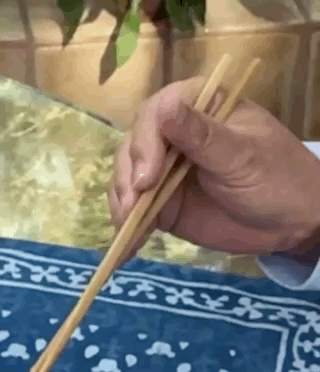
Index finger assists in extending tips
The second way Italian Grip extends tips apart involves the index finger. In the following video clip, the index finger now plays a role in moving the top chopstick. The clip shows the complete alternate motion of this grip.
Starting at the open posture, the base of the thumb closes in on the top chopstick, squeezing it against all other fingers, towards the payload posture. As this happens, the index finger is lifted away from chopsticks, into a position where it has leverage to initiate the next step in the motion.
At the payload posture, the index finger is now in position to push the top chopstick downward, and to the left, causing the tip of the stick to drop down with an under swing. In this process, the index finger is not the only actor causing the top stick to drop. It is an assistant. Both gravity and hand swinging are still in play, at a lesser degree.
The following illustrates key moments in this movement. Below left is the payload posture where all fingers clutch the two sticks together. The center image shows the index finger getting into position to start the under swing push. The image to the right shows that the index finger has pushed the top chopstick down, reaching the open posture.
As mentioned earlier, this way of opening chopsticks is similar to Scissorhand. The under-swing motion of the top chopstick is the same. However, finger dynamics are very different, due to the position and function of the thumb, as well as the orientation of the palm. In Scissorhand, the index finger never loses surface contact with the top chopstick. The index finger and the thumb collaborate to open and close tips. Scissorhand relies much less on gravity for assistance.
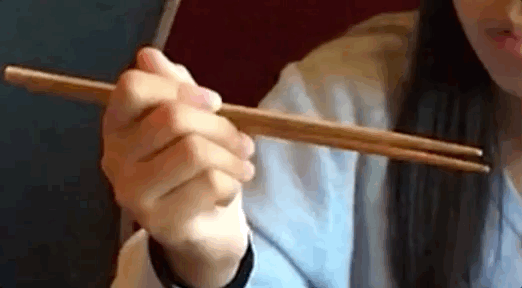
Thumb rolls top stick to extend tips
The third way Italian Grip extends tips of chopsticks is unique to it. This is a special move that only Italian Grip can pull off, given its chopstick and finger arrangement.
The following video clip shows this move. Keep your eye on the rear end of the top chopstick. Look at spotted patterns printed on the chopstick surface. Note how the chopstick is “rolled” during this special move. The roll is based on the same planetary gear principle that fuels the movement of Standard Grip. However, Italian Grip rolls the stick in the opposite direction, since it is an under swing variant.
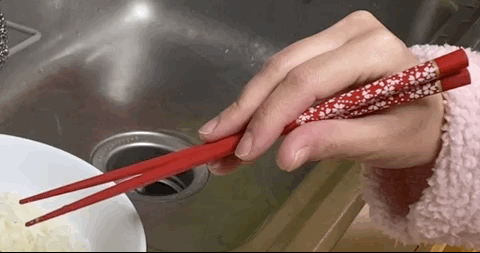
Contrast the rolling of the top chopstick in Italian Grip shown above, to the roll in Standard Grip shown below. The planetary gears principle remains the same in both cases. The anatomy of the human hand is such that when the chopstick is rolled clockwise, the tip is extended up and right. When the chopstick is rolled counterclockwise, the tip is swung down and left.
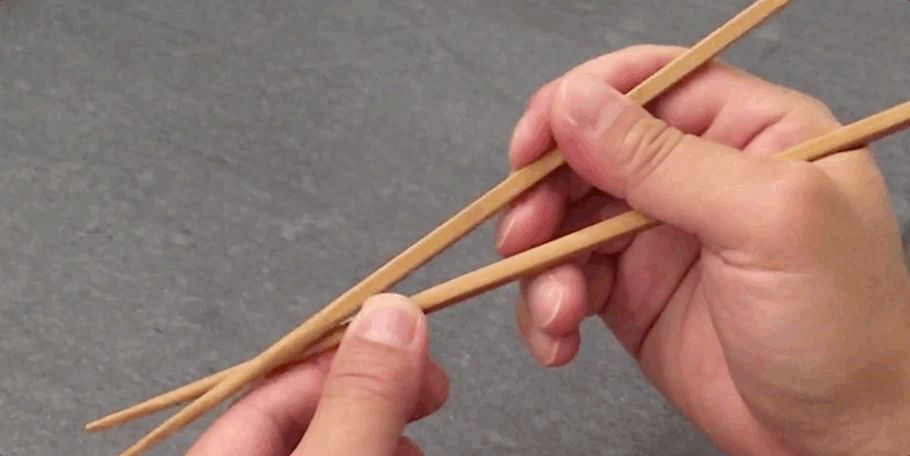
The difference between these two grips is that, Italian Grip rolls the top stick clockwise, to move the tip downward to the classic-swing open posture. But Standard Grip rolls the stick counterclockwise, to move the tip upward, again to the under-swing open posture.
Standard Grip uses rolling both to open and to close tips of chopsticks. The movement from open posture to close posture is an exact mirror of the movement from closed to open.
Italian Grip, however, only rolls the top chopstick to extend tips open. It clutches fingers to close tips, without rolling the top chopstick in the opposite direction. In other words, the alternating motion of Italian Grip is not symmetrical.
Here is the video clip again. Track the movement of the thumb. As the hand clutches two chopsticks closed, the thumb moves forward and downward, to reposition itself for the next cycle of rolling. It needs to reset its position at the end of every cycle, so it can perpetually roll the top chopstick in one single direction.

The following illustrates key moments in the clockwise rolling of the top chopstick, as Italian Grip extend the tip of the top chopstick in an under-swing move. We start with the payload posture on the left, and end up in the open posture on the right.
The following illustrates key moments in the clutching of chopsticks, from the open posture back to the closed posture. No rolling is involved.
Picking up food with a tilted payload posture
So far we have focused on the opening and closing of chopstick tips. Now we look at how Italian Grip picks up food with a tilted payload posture. The next video clip includes two sequences: clutching two chopsticks together to pinch food, and then tilting and lifting chopsticks to pick up food.
Following images show the key moments in the clutching phase. Fingers go from a relaxed open posture (below left), to a tensed payload posture (below right). All four fingers plus the thumb participate in squeezing the two chopsticks closed.
Following images show how food is lifted off the bowl. Unlike other grips such as Scissorhand, Italian Grip lays chopsticks relatively parallel to the table surface. This is a feature that Italian Grip shares with Cupped Vulcan – both have the palm facing down while picking up food. From the payload posture (below, leftmost), the hand tilts tips of chopstick up slightly (below, rest of images), laying chopsticks even more parallel to the table surface. This is how Italian Grip lifts food.
If chopsticks are not tilted up this way, food will often slip off. This is due to the way tips of chopsticks enclose food items in this grip. Because of the scissor-like nature of the payload posture, and the slippery surface of tips, additional squeezing by fingers not only pinches food, but also pushes it outward at the same time. This is explained in details in Scissorhand.
Italian Grip cannot flip its payload
Cupped Vulcan has a special payload-flipping move which is not possible to perform with Italian Grip. That move is shown below. Focus your attention on the slice of lemon being flipped 180° degrees, while the hand retains a palm-downward orientation. How is this done?
The Cupped Vulcan article goes into details on this move. The key factor that enables this move is the separation of the two chopsticks. At no time during the motion of transporting the slice do the two chopsticks come into contact with each other. Their separation at the point where fingers hold chopsticks keeps the two chopsticks parallel to each other, and not at an angle as is the case in Italian Grip. The two chopsticks in this configuration, together with the payload and fingers, form a spatial four-bar linkage. This enables the hand to twist tips of chopsticks, turning an under-swing payload posture into a classic-swing payload posture. The end result is a strong compression forces, at the classic-swing payload posture.

Jihyo from TWICE wielding Italian Grip
Our in-depth article Chopstick Grips of TWICE Members describes chopstick grips of all 9 TWICE members. One of them, Jihyo, is a master of the topic at hand. They gave her long cooking chopsticks in both reality TV episodes we analyzed. Jihyo used them unfazed, and we’ve gotten great footage out of these two episodes. Here they are.
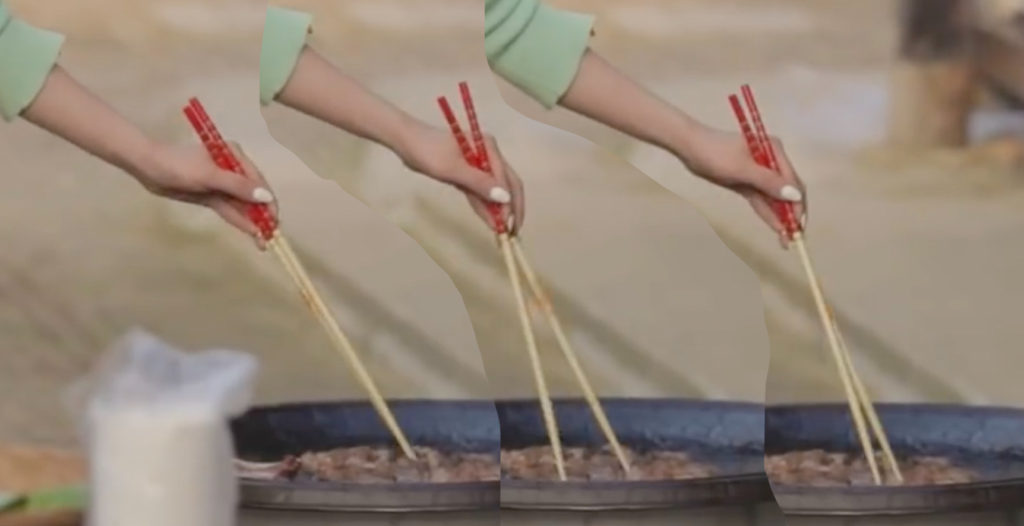
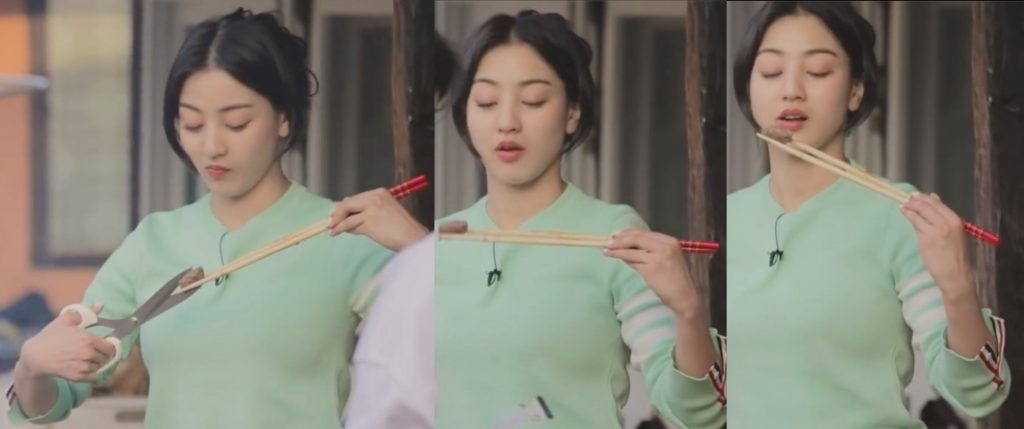
Following pictures illustrate the compression posture of Italian Grip, as seen from different perspectives.
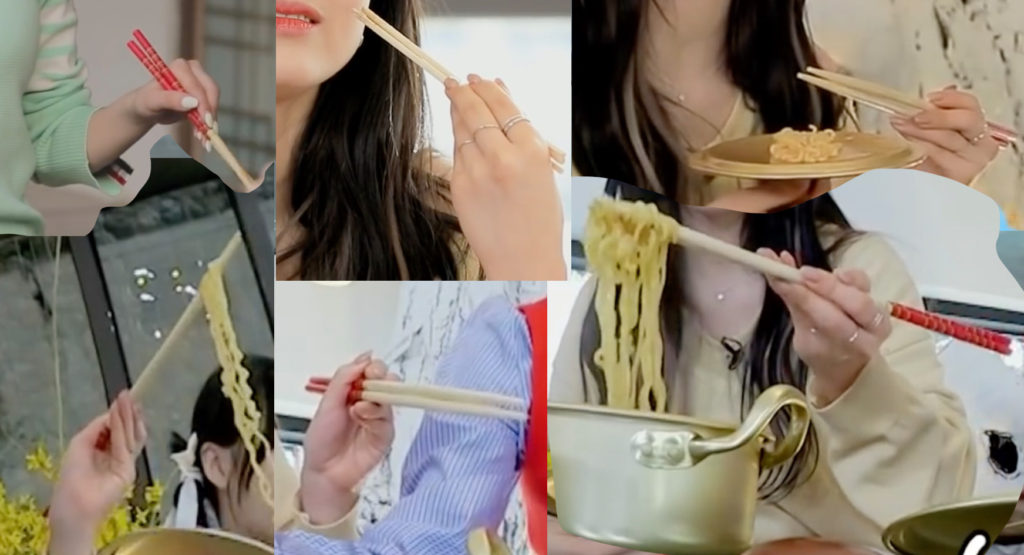
Pictures below illustrate the compression posture (below left), the relaxed closed posture (below center), and the open posture (below right).

Following images show typical hand and finger movements for picking up food, and for moving it to the mouth. A distinct feature of “cupped” grips such as Italian Grip and Cupped Vulcan is that, as the hand lifts off the food item, the back of the hand faces upward. This is the opposite of Lateral chopstick grips where the palm instead faces upward.
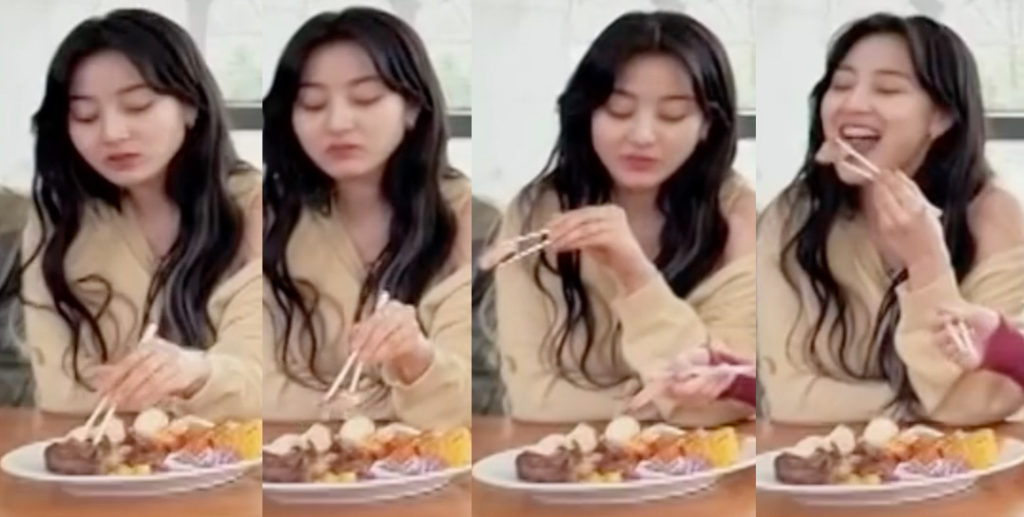
Variant with rolled bottom chopstick
Updates in 2022: we have documented a variant of Italian Grip with “rolled bottom chopstick”. Earlier in this article we have explained how the index finger and the thumb roll the top chopstick to extend tips apart. In this new variant, the rest of the fingers work together to roll the bottom chopstick as well. Because of this small change, the practitioner is able to extend chopstick tips much further apart with this variant.
Following video slows down sections of a clip, in order to highlight how this variant works.
Last words
If Italian Grip works well for you, that is great. If you would like to add more alternative grips into your chopsticking repertoire, then start with learning Standard Grip.
Taiwanese: 卜按盞
This grip is known as 卜按盞 (Beh án-chóaⁿ) in Taiwanese 白話字, or “beh án-tsuánn” in 台羅. Unlike in English, there are actually several common phrases that exactly express this Italian gesture. We have chosen the politest form of them all. An alternative 漢文 for this grip is: 欲按怎.

